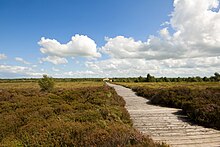Corlea Trackway
While today a generally flat and open landscape, in the Iron Age it was covered by bog, quicksand, and ponds, surround by dense woodlands of birch, willow, hazel and alder while higher ground was covered by oak and ash.[4] The majority of these toghers are constructed from woven hurdles laid on heaped brushwood on top of the surface, built to be used by people on foot.Raftery estimated that the sleepers alone amount to a 300 large oak trees, or a thousand wagon-loads, with a similar volume of birch for the rails.[7] Massive structures such as the Corlea Trackway may also have served to get into the bog, perhaps for ritual purposes, rather than merely to cross it.[9] The Corlea Trackway, seemingly constructed in a single year, has suggested comparisons with the Irish language tale Tochmarc Étaíne (The Wooing of Étaín), where King Eochu Airem sets Midir tasks such as planting a forest and building a road across a bog where none had ever been before at a place called Móin Lámraige.



Keenagh, County LongfordMidlands of IrelandCausewayGaelic IrelandOffice of Public WorksNational MonumentNational monument of IrelandIron AgetrackwayKeenaghLongford, County LongfordSiege of CarthageBord na Mónapower stationsElectricity Supply Boardwillowradiocarbon datedBronze AgeBarry Rafteryhurdlescorduroy roadsDendrochronologicalbarrowsTochmarc ÉtaíneEochu AiremSweet TrackHistory of roads in IrelandR392 road (Ireland)CruachanUisnechPryor, Francis